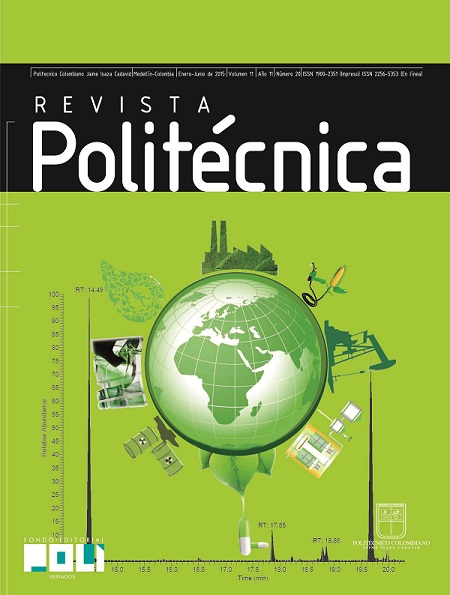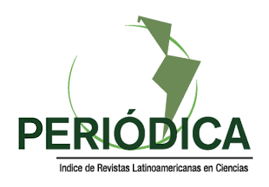Photocatalytic degradation of hydrolyzed reactive red 120 and reactive blue 4 using nitrogen or iron doped tio2
Keywords:
Photocatalytic degradation, reactive red 120, reactive blue 4, TiO2, N-TiO2, Fe-TiO2Abstract
The heterogeneous photocatalytic degradation of dyes reactive red 120 and reactive blue 4 under ideal solutions and hydrolysates dyes simulating a staining process with an initial concentration of 50 mg • L-1 was studied, using 200 mg • L-1 of TiO2 doped with Fe or N. Total degradation of both dyes was achieved with the addition of an auxiliary oxidizing agent such as hydrogen peroxide (H2O2) at a concentration of 12.0 mM. Such degradation was achieved after one hour of reaction for doped catalysts (N-TiO2 and Fe-TiO2). For solutions of hydrolysed dye that simulated waste water from the textile industry was found that the pH adversely affects dye degradation due to repulsion between the photocatalysts and dyes. In all the studied cases further degradation of reactive red dye 120 was observed relative to reactive blue 4, which can be associated with the complex molecular structure of the second dye.
Article Metrics
Abstract: 908 PDF (Español (España)): 449References
Balapure, K., Bhatt, N., Madamwar, D. Mineralization of reactive azo dyes present in simulated textile waste water using down flow microaerophilic fixed film bioreactor. Bioresource Technology, 175, 1-7, 2015.
Levin, L., Grassi, E. y Carballo, R. Efficient azoic dye degradation by Trametes trogii and a novel strategy to evaluate products released. International Biodeterioration & Biodegradation. 75, 214-222, 2012.
Gözmen, B., Kayan, B., Gizir, A. y Hesenov, A. Oxidative degradations of reactive blue 4 dye by different advanced oxidation methods. Journal of Hazardous Materials, 168, 129-136, 2009.
Jamal, F., Qidwai, T., Pandey, P., Singh, R. y Singh, S. Azo and anthraquinone dye decolorization in relation to its molecular structure using soluble Trichosanthes dioica peroxidase supplemented with redox mediator. Catalysis Communication, 12, 1218-1223, 2011.
Basturk, E., Karatas, M. Decolorization of antraquinone dye Reactive Blue 181 solution by UV/ H2O2 process. Journal of photochemistry and Photobiology A: Chemistry, 299, 67-72, 2015.
Tkachenko, O., Panteleimonov, A., Padalko, I., Korobov, A. y Gushiken, Y. Silica functionalized with 1-propyl-3-methylimidazolium chloride as an efficient adsorbent for the removal of Eosin Yellow and Reactive Blue 4. Chemical Engineering Journal, 254, 324-332, 2014.
Golder, A., Hridaya, N., Samanta, A. y Ray, S. Electrocoagulation of methylene blue and eosin yellowish using mild steel electrodes. Journal of Hazardous Materials, 127, 134-140, 2005.
Ferella, F., De Michelis, I., Zerbini, C. y Veglio, F. Advanced treatment of industrial wastewater by membrane filtration and ozonization. Desalination. 313, 1-11, 2013.
Muthukumar, M., Sargunamani, D. y Selvakumar, N. Statistical analysis of the effect of aromatic, azo and sulphonic acid groups on decolouration of acid dye effluents using advanced oxidation processes. Dyes and Pigments, 65, 151-158, 2005.
Pey Clemente, J. Aplicación de procesos de oxidación avanzada (fotocatálisis solar) para tratamiento y reutilización de efluentes textiles [PhD Tésis]. Universidad Politécnica de Valencia, 2008.
Garcés, L.F., Hernández, M.L., Peñuela, G.A., Rodríguez, A. y Salazar, J.A. Fotodegradación sensibilizada con TiO2 del colorante rojo recoltive utilizando lámpara de luz UV. Producción más Limpia. 1, 54-62, 2006.
Industria textil, water treatmen soluttions, lenntech. Disponible en: http://www.lenntech.es/industriatextil. htm[consultado el 8 de febrero de 2009].
Vergara J., Pérez, J.P., Suárez, R. y Hernández, I. Degradation of reactive red 120 azo dye in aqueous solutions using homogeneous/heterogeneous iron systems. Revista Mexicana de Ingeniería Química. 11, 121-131, 2012.
Suwannaruang, T., Rivera, K.K.P., Neramittagapong, A. y Wantala, K. Effects of hydrothermal temperature and time on uncalcined TiO2 synthesis for reactive red 120 photocatalytic degradation. Surface and Coating Technology. 271, 192-200, 2015.
Vakili, M., Rafatullah, M., Salamatinia, B., Hakimi, M. y Zuhairi A. Carbohydrate Polymers. 2015. Artículo in press.
Garcés, L.F., Mejía, E.A, y Santamaría, J.J. La fotocatálisis como alternativa para el tratamiento de aguas residuales. Revista la Sallista de investigación. 1, 83-93, 2004.
Suarez, W., Penagos, P., Manrique, L. y Gallego, D. Efecto de la estructura quimica de los colorantes en su fotoxidacion catalitica. Ingenieria Química. 435, 150-158, 2006.
Rengifo-Herrera J.A., Kiwi, J. y Pulgarin, C. N, S co-doped and N-doped Degussa P-25 powders with visible light response prepared by mechanical mixing of thiourea and urea. Reactivity towards E. coli inactivation and phenol oxidation. Journal of Photochemistry and Photobiology A: Chemistry, 205, 109–115, 2009.
Sood, S., Umar, A., Kumar, S. y Kumar, S. Highly effective Fe-doped TiO2 nanoparticles photocatalysts for visiblelight driven photocatalytic degradation of toxic organic compounds. Journal of colloids and Interface Science. 450, 213-223. 2015.
Fisicoquimica de la tintura con colorantes reactivos sobre fibras celulasicas. Disponible en: http://www.redtextilargentina.com.ar/index.php/fibras/f-ennoblecimiento/233-insumos-para-elennoblecimiento-de-fibras/colorantestextiles/colorantes-sinteticos/colorantesreactivos/fisicoquimica-de-la-tintura-con-colorantesreactivos/415-fisicoquimica-de-la-tintura-concolorantes-reactivos. [Consultado el 10 de Agosto de 2014].
Garcés, L.F., Mejía, E.A. y Peñuela, E.A. Cinética de degradación y mineralización del colorante Rojo Amaranto por medio de fotocatálisis con luz solar, Revista Lasallista de Investigación, 2, 19-26, 2005.
Nagaveni, K., Hedge, MS., Ravishankar, N., Subbanna, G., Madras, G. Synthesis and Structure of Nanocrystalline TiO2 with Lower Band Gap Showing High Photocatalytic Activity. Langmuir, 20, 2900-2907, 2004.
Gumy, D., Morais, C., Bowen, P., Pulgarin, C., Giraldo, S., Hajdu, R. y Kiwi, J. Applied Catalysis B: Environmental. 63, 76-84, 2006.
Castillo, J. Desarrollo de un método de eliminación de Escherichia coli en agua usando un proceso avanzado de oxidación (PAO). Tesis Profesional. Universidad de las Américas Puebla. 2009.
Wantala, K., Tipayarom, D., Laokiat, L. y Grisdanurak, N. Sonophotocatalytic activity of methyl orange over Fe(III)/TiO2. React. Kinet Catal Lett. 97. 249-254. 2009
You, J.H., Hsu, K.Y. Influence of chelating agent and reaction time on the swelling process for preparation of porous TiO2 particles. Journal of the European Ceramic Society. 30, 1307-1315, 2012.
García, E., Féliz M. R., y Capparelli A. L., Effect of temperature on hydrogen peroxide photolysis in aqueous solutions. Journal of Photochemistry and Photobiology A: Chemistry. 110, 235-242, 1997.
Valencia, S.H., Marin, J.M. y Restrepo, G.M. Efecto del pH en la degradación fotocatalítica de materia orgánica natural. Información tecnológica 22, 57-66, 2011.


 _
_


















